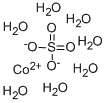dinitrogen trioxide
- CAS NO.:10544-73-7
- Empirical Formula: N2O3
- Molecular Weight: 76.011
- EINECS: 2341285
- SAFETY DATA SHEET (SDS)
- Update Date: 2025-01-27 09:38:02

What is dinitrogen trioxide?
Chemical properties
blue liquid; used as an oxidant in special fuel systems [HAW93]
Definition
ChEBI: Dinitrogen trioxide is a nitrogen oxide.
General Description
A blue liquid with a sharp, unpleasant chemical odor. Density 1.447 g / cm3. Low-boiling (boiling point 3.5°C) and held as a liquid by compression. Partially dissociates into NO and NO2. Strong irritant to skin, eyes and mucous membranes. Vapors very toxic by inhalation. Used in special purpose fuels. Under prolonged exposure to intense heat the container may rupture violently and rocket.
Reactivity Profile
dinitrogen trioxide is an oxidizing agent. Nonflammable but may cause fires when mixed with combustible materials. Reacts with reducing agents to generate heat and products that may be gaseous (causing pressurization of closed containers). The products may themselves be capable of further reactions (such as combustion in the air). Catalyzes ignition of phosphine gas [Edin. Roy. Soc. 13:88. 1935]. A mixture with caprolactam dissolved in acetic acid is explosive unless effectively cooled. Incompatible with phosphorus, or other reduced materials Reactivity likely to resemble that of nitrogen dioxide and nitrogen tetraoxide.. .
Health Hazard
TOXIC; may be fatal if inhaled or absorbed through skin. Fire will produce irritating, corrosive and/or toxic gases. Contact with gas or liquefied gas may cause burns, severe injury and/or frostbite. Runoff from fire control may cause pollution.
Fire Hazard
Substance does not burn but will support combustion. Vapors from liquefied gas are initially heavier than air and spread along ground. These are strong oxidizers and will react vigorously or explosively with many materials including fuels. May ignite combustibles (wood, paper, oil, clothing, etc.). Some will react violently with air, moist air and/or water. Cylinders exposed to fire may vent and release toxic and/or corrosive gas through pressure relief devices. Containers may explode when heated. Ruptured cylinders may rocket.
Properties of dinitrogen trioxide
| Melting point: | -103.15°C |
| Boiling point: | 2°C (estimate) |
| Density | 1.400 |
| solubility | reacts with H2O |
| form | gas |
| color | blue solid or liquid
(low temperature) |
| EPA Substance Registry System | Nitrogen trioxide (10544-73-7) |
Safety information for dinitrogen trioxide
Computed Descriptors for dinitrogen trioxide
New Products
4,4-Difluoropiperidine hydrochloride tert-butyl 9-methoxy-3-azaspiro[5.5]undecane-3-carboxylate Indole Methyl Resin N-Isopropylurea N,N-Dicyclohexylcarbodiimide(DCC) MELDRUMS ACID 5-METHYLISOXAZOLE-4-CARBOXYLIC ACID Magnessium Bis glycinate Zinc ascorbate 1-bromo-2-butyne 2-acetamidophenol 9(10H)-anthracenone Erythrosin B, 4-Piperidinopiperidine 2-((4-morpholinophenylamino) (methylthio) methylene) malononitrile 2,4-dihydroxybenzaldehyde 3-(4-morpholinophenylamino)-5-amino-1H-pyrazole-4-carbonitrile Methyl 2-methylquinoline-6-carboxylate 2,6-dichloro-4-nitropyridine 4-Bromo-2-chlorobenzonitrile 2-(benzylamino)acetic acid hydrochloride 4-(tert-Butoxycarbonylamino)but- 2-ynoic acid 3,4-dihydro-2H-benzo[b][1,4]dioxepine 1-Phenyl-1-cycloprppanecarboxylicacidRelated products of tetrahydrofuran








You may like
-
 3-(4-amino-1-oxoisoindolin-2-yl)-1-methylpiperidine-2,6-dione 98%View Details
3-(4-amino-1-oxoisoindolin-2-yl)-1-methylpiperidine-2,6-dione 98%View Details -
 1-methylindoline-2,3-dione 98%View Details
1-methylindoline-2,3-dione 98%View Details
2058-74-4 -
 614-19-7 98%View Details
614-19-7 98%View Details
614-19-7 -
 3112-85-4 Methyl phenyl sulfone 98%View Details
3112-85-4 Methyl phenyl sulfone 98%View Details
3112-85-4 -
 20677-73-0 (2,2-diethoxyethyl)methylamine 98%View Details
20677-73-0 (2,2-diethoxyethyl)methylamine 98%View Details
20677-73-0 -
 3-(4-(hydroxyamino)-1-oxoisoindolin-2-yl)piperidine-2,6-dione 98%View Details
3-(4-(hydroxyamino)-1-oxoisoindolin-2-yl)piperidine-2,6-dione 98%View Details -
 57381-49-4 2-bromo-4-chlorobenzonitrile 98%View Details
57381-49-4 2-bromo-4-chlorobenzonitrile 98%View Details
57381-49-4 -
 4,6-dichloropyrimidine-5-carbaldehyde 98%View Details
4,6-dichloropyrimidine-5-carbaldehyde 98%View Details
5305-40-8
